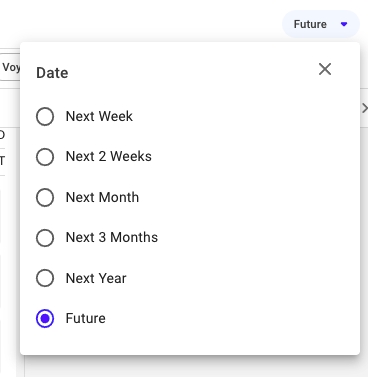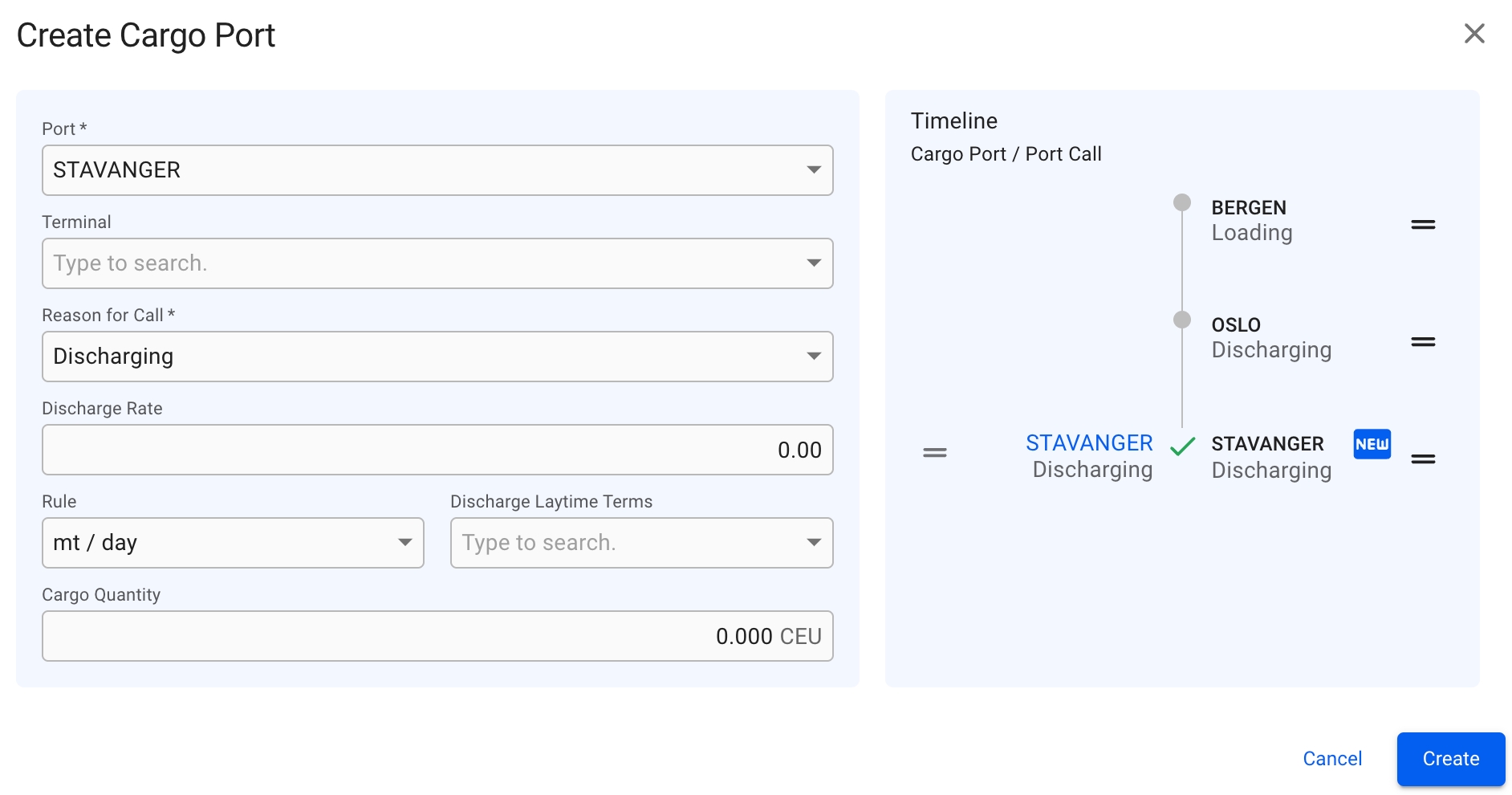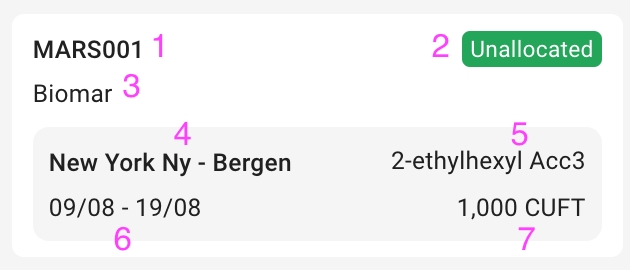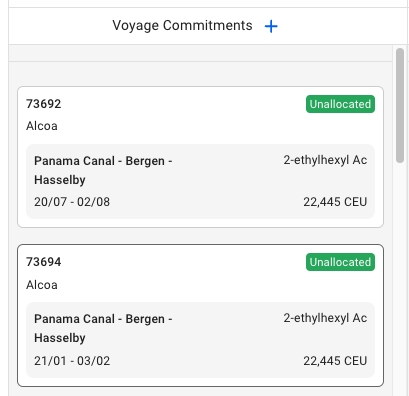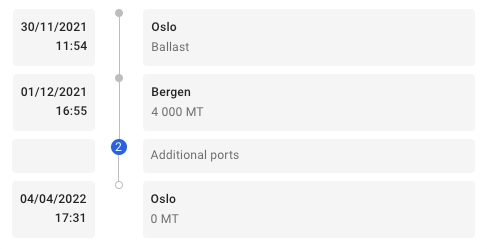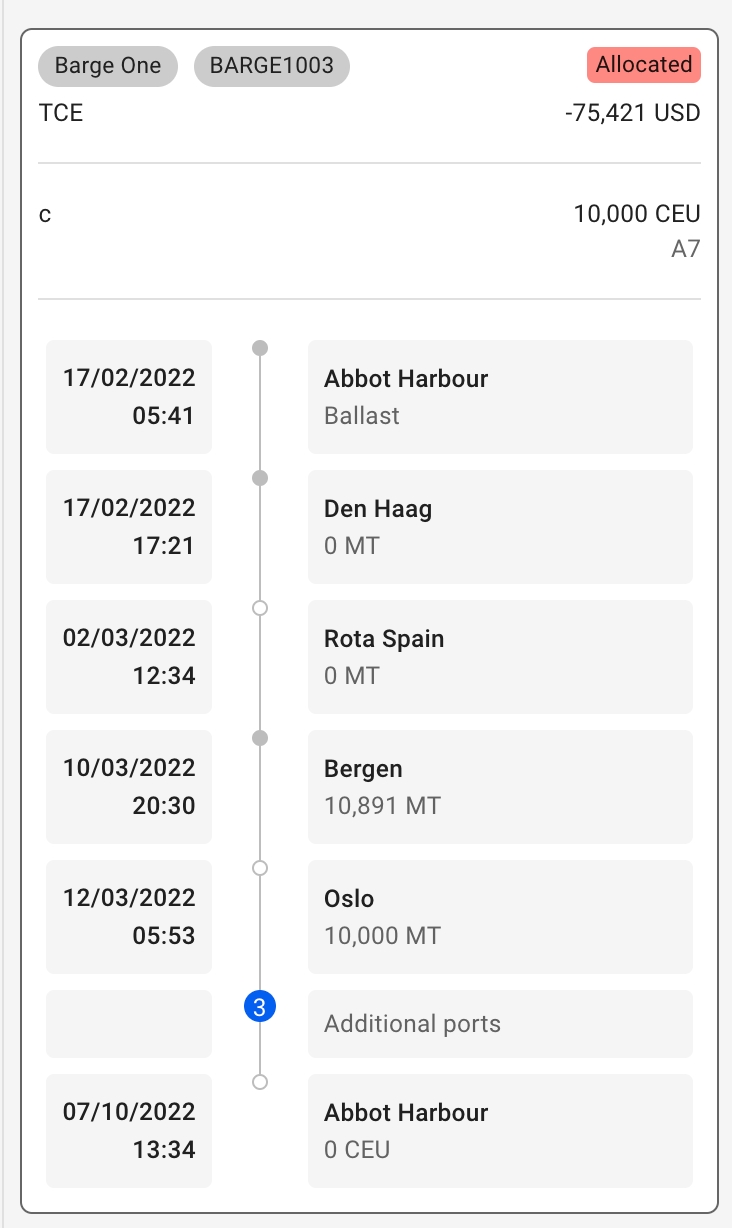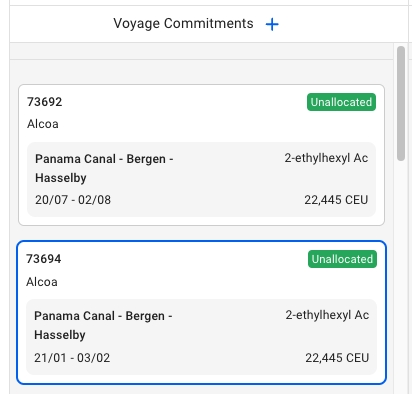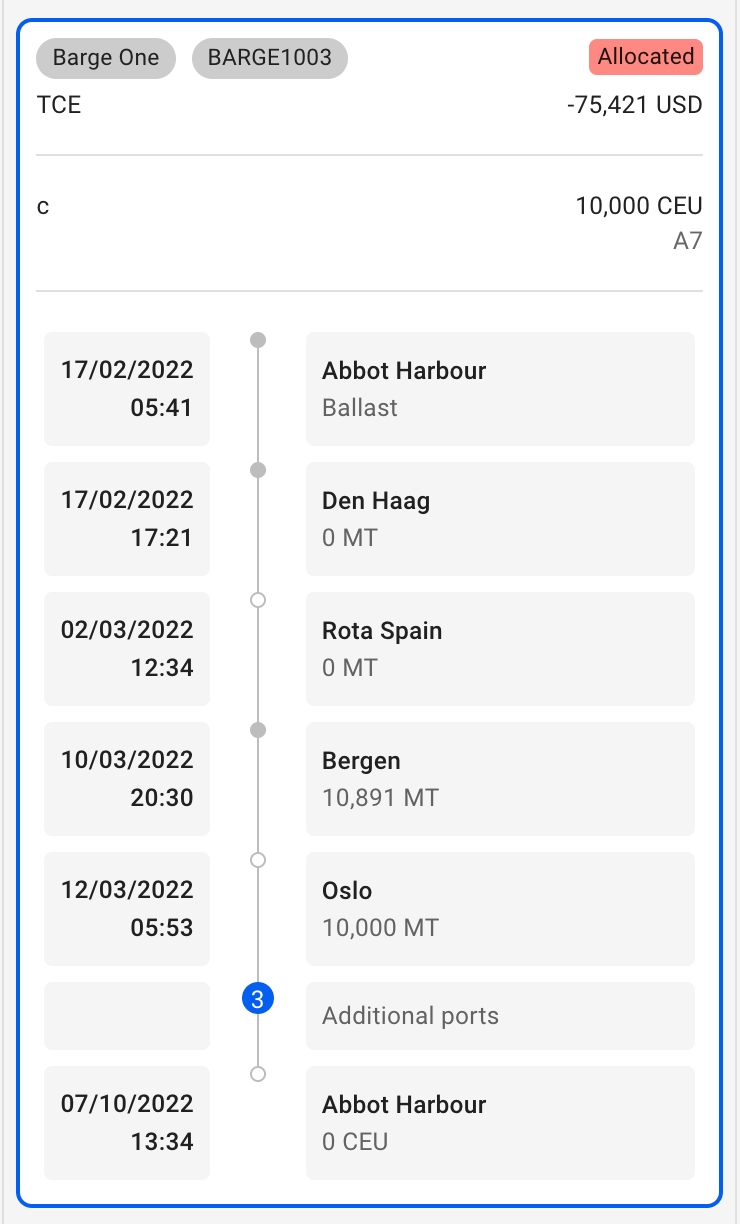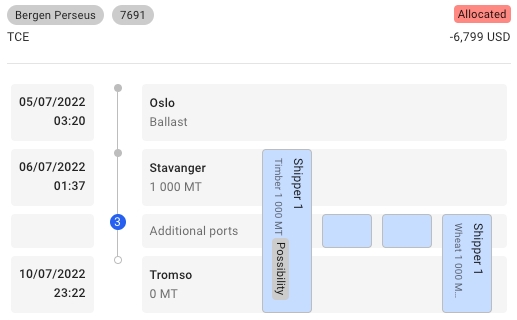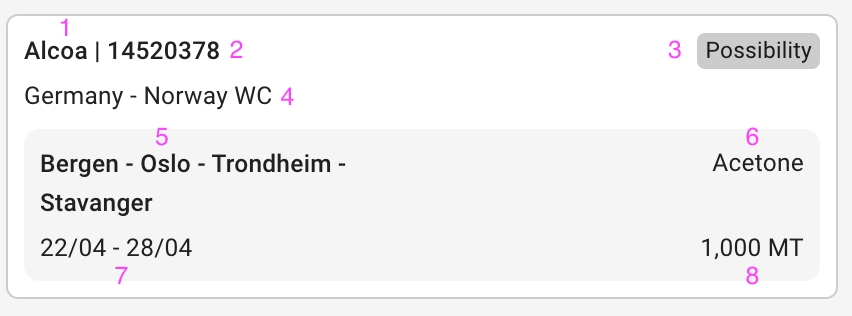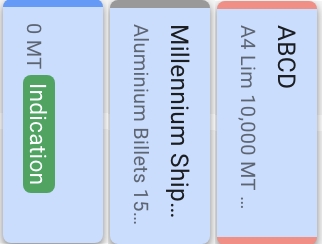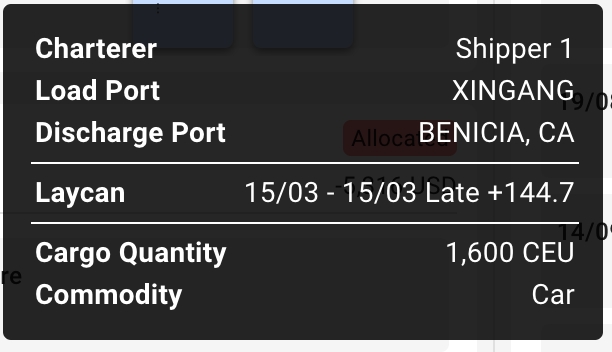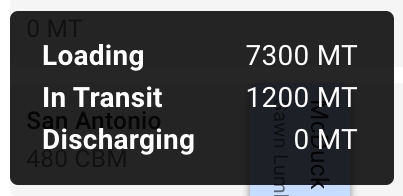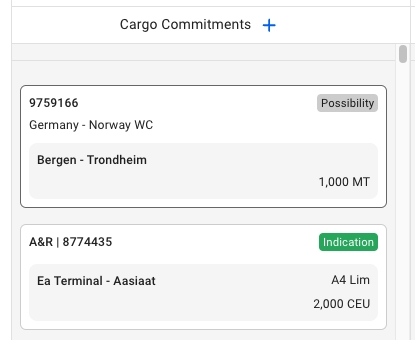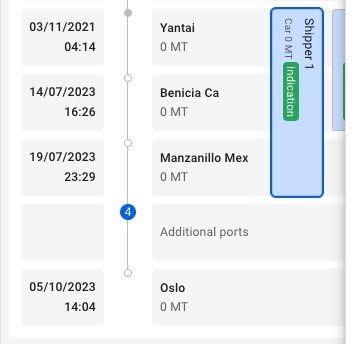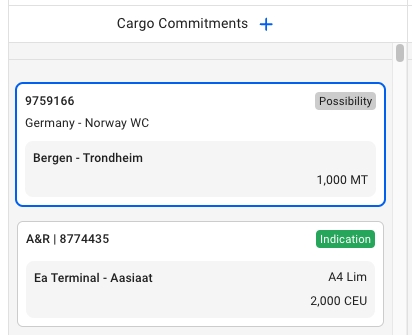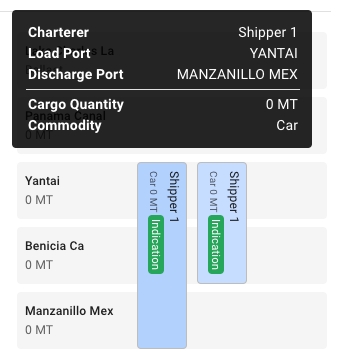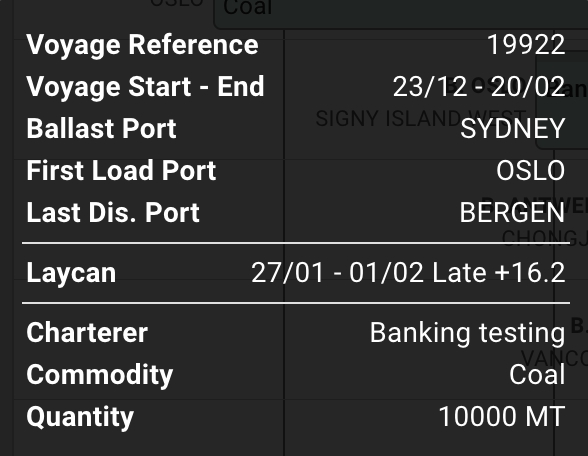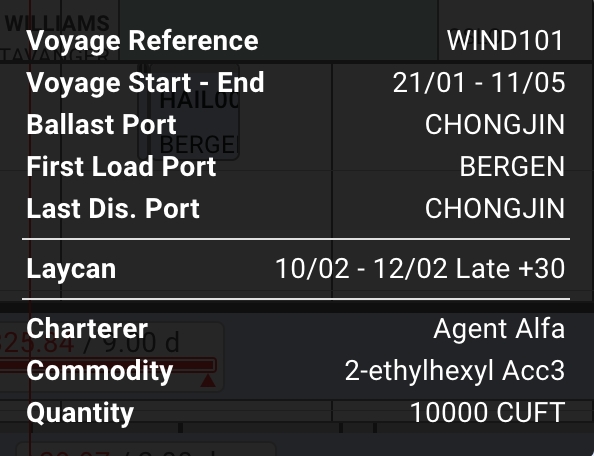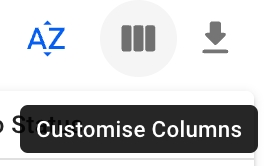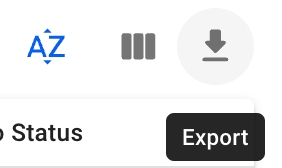Loading...
Loading...
Loading...
Loading...
Loading...
Loading...
Loading...
Loading...
The Voyages tab can be found in the Fleet Plans module. It contains a list of all voyages that can be found within a scenario. This includes voyages of statuses: unallcoated, allocated, estimated and nominated.
The following voyage information can viewed from the list:
Clicking on a voyage opens the voyage drawer and gives access to additional information and actions.
You can read more about the actions here: Voyage Actions.
There are several sorting and filtering options available for you to narrow down what you include in the list view.
The Fleet Plans module allows you to allocate voyages and cargoes in MASTER and different scenarios without making any changes to your master Fleet Plan.
At the top center of the screen, the selected scenario is displayed:
Below the scenario selector, there are three tabs to access different views of the scenario schedule:
In the FAS board, we now have "master" Date filter, that will filter voyages and cargoes in all of the boards, more efficiently. We have the filtering possibilities for Next Week, Next 2 Weeks, Next Month, Next 3 Months, Next Year and Future (meaning the past 2 weeks and beyond). The default is set at 'Next 3 Months'.
All voyages and allocated cargoes are filtered with respect to the voyage's end date date. The unallocated cargoes in their respective Cargo Commitments column, are filtered with respect to the cargo's laycan from- and to- dates.
For a scenario != MASTER, the Date filter is also clearable. Meaning, you can clear the filtering of the selected date range, resulting in the list showing for all results instead, regardless of cargo's laycan dates and the voyage's end date.
On the Open Positions and Cargo Management boards, specifically, you will be able to use the toggle functionality:
By turning the toggle off, you will be able to hide the Voyage Commitments, or Cargo Commitments, making the allocated sections for voyages and cargoes the full view.
Meanwhile, in the Scheduler board, you have two hide functionalities:
By clicking on, for instance, the "Hide Commitments" toggle, you will hide the whole Commitments section, making the Schedule section the full view. And opposite action for "Hide Schedule" (you are also able to hide both sections, then you will get an "empty" full view).
It is possible to access the by clicking on any allocated voyage in any of the boards/lists in FAS (or ), and then opening the 'Cargo' tab. Also, in the , you can access the cargo drawer by clicking on a cargo commitments to the left, or directly on an allocated cargo on the right (on the allocated voyages).
Inside a chosen , you will be able to create new cargoes in based on allocated or unallocated voyages.
In the , next to the Cargo Commitment title, there is a icon. Here, you can find all the different types of cargoes to create, and their modals. Follow the same steps as to create a new cargo. The new cargo will be placed in this Cargo Commitments column based on the given Laydays. If not given, then they will be placed at the bottom of the list.
On any allocated voyage in FAS (or ), you can find the 'Cargo' tab at the top of the voyage drawer. Above the cargo list, there is a icon there. Also here, you can of cargoes, and display their modals. But- there is a new design here as well:
On the allocated cargoes mentioned above, you will have drag and drop options on both sides of time timeline. On the left side, you will be able to drag a cargo port to match with a corresponding port call, but they both have to have the same reason for call. On the right side, you will be able to drag the whole CP/PC row to change the order in these ports on the voyage. The same features are implemented in the new Create Cargo Port modal:
In Open Positions Board: to allocate or unallocate a voyage, you can drag and drop the different voyage cards between the Voyage Commitments column (the unallocated voyages) and the different vessels displayed.
In Scheduler Board: to allocate or unallocate a voyage, you can drag and drop the different voyage bars between the COA and SPOT rows (the unallocated voyages) and the different rows of vessels displayed.
In Cargo Management board: to allocate or unallocate a cargo, you can drag and drop the different cargo cards between Cargo Commitments column (the unallocated cargoes) and the different allocated voyages displayed.
In the secondary actions menu (3 dots), it's possible:
To unallocate a cargo (unless it's already unallocated)
To allocate a cargo
To delete a cargo
To relet a cargo
To tranship a cargo
To preship a cargo
To transfer a cargo
To edit Cargo Reference
To connect to CoA
To view the Audit Log
To access or upload voyage Attachments
The actions applies to both MASTER scenario and other scenarios.
You can filter unallocated cargoes based on Charterer, Cargo, Trade and Area.
You can filter the allocated voyages based on Voyage, Vessel, Area and More.
More containing Commodity, Charterer, Trade, Commodity Class and Cargo Type.
You can filter the cargoes based on Cargo Reference, Counterpart, Commodity, Vessel, Voyage Reference and Cargo Status. This are placed above the list.
The board has two main areas- unallocated voyages (Voyage Commitments) on the left, and allocated voyages on the right.
Each element in the board represents either a voyage (unallocated), a voyage with cargo(s) (allocated), a vessel, a vessel open position card or a last port call card.
We call the yellow card on the vessel columns the vessel open position card. It displays the start of the schedule of each ship that is displayed on the board. You can click on the card to open the vessel open position drawer. For any scenario that is not the MASTER, you can edit the port and date of the vessel open position. This changes where your ship starts in the scenario and reschedules the consecutive voyages.
In the Voyage Commitments column, the left-most column of the board, we have a list of Unallocated Voyages with a new design:
The Allocated Voyages Card also contains a detailed timeline:
On the left side of the Voyage Card, all the arrival times are listed. The date and time listed for the Ballast Port is the voyage start date. On the right side of the timeline, the port names are listed, including the Ballast Port. The total cargo gross weight on board after the port call is listed under the port name.
Number of Displayed Ports
It is possible to change how many ports are listed at a time by using the settings. The minimum amount of ports that can be displayed is 3, the Ballast Port, the first load port and the last discharge port of a voyage. The number in the blue circle indicates how many ports are hidden.
For each vessel we have a card with information about when it is next available. This can be found after the last voyage in a vessel's schedule.
In the Open Positions Board you can drag and drop voyages to allocate or unallocate them, move them between vessels and change their order on a vessel.
You have a large variety of filters available on the board. Filtering for Voyage Commitments (left-most column) and Allocated Voyages (rest of the columns) is separate. Filtering is persisted when navigating between the boards as well as when navigating to different menu items.
Each of the unallocated voyage cards now have a new light grey border, and when you hover, it will be marked with a darker one to clearly indicate which one you are hovering over.
When selecting one of these cards, a blue border and thicker border will display along with opening the Voyage drawer:
We have here as well now added a new light grey border, and when you hover over it, here too it will be marked with a darker one to clearly indicate:
When selecting one of the allocated voyages here too, the same type of blue border will display: along with opening the Voyage drawer as well:
The Active State
For both the unallocated and allocated voyages, the blue active border will stay active on the board until you do another action.
This border also displays and stays active when creating a new voyage, and with the use of drag & drop of the allocated cargoes and/or the unallocated voyages.
Now when you hover over a Vessel Open Position card, it displays a darker grey tone on its border:
When you select the card, the border becomes the same blue active border as previously mentioned, along with opening the Vessel Open Position drawer:
This border will stay active until you do another action on the board.
You can select the number of columns to show in the board either by moving the slider or by typing in a number.
You can select the number of ports to show in the port call timeline either by moving the slider or by typing in a number. The ballast, first loading and last discharging ports are always visible.
The column grouping decides which column a card should go into. The default setting is to group by vessel, but you can also select load area or discharge area. The area groupings depends on the selected area report under account preferences.
The row grouping setting decides how the cards are grouped vertically. By default there is no row grouping. You can also select to group by month or week.
The Cargo Management Board displays all allocated voyages and the cargos allocated to them. It also shows the unallocated cargos in Cargo Commitments column. For details on the Vessel Open Positions, voyage cards and board settings, see .
The Cargo Management Board displays all cargos belonging to the selected scenario. In the left-most column, we display the unallocated cargos (Cargo Commitments column), which are cargos that have not yet been allocated to a voyage. The other columns display voyage cards with the cargoes allocated to them.
Each cargo contains the fields:
The right side of the Cargo Management Board contains all the allocated voyages and their cargos. On the right side of a voyage card, the cargo cards allocated (or dragged) to the voyage are displayed. Each cargo displays the Charterer, Gross Weight and Cargo Status, while illustrating graphically the Load Ports and Discharge Ports. These cargos can be moved by dragging and dropping between the voyages of the same Trade:
With this newer design of the cargos on the voyage card, you will be able to graphically see at what ports a cargo has its Load- and Discharge ports. You can easily track all the Port Call rows of the cargo by looking at the vertical span of the specific cargo (the blue area). It is also possible to scroll to the right to see all the cargoes allocated on the same Port Calls. If the ports are "hidden", they will display as shown above.
The Cargo Cards also has indication lines to help you interpret the Laydays and Arrival Windows for each cargo, graphically.
Laydays: indication line at the top of the cargo. Arrival Window: indication line at the bottom of the cargo.
Color indicator:
if early: blue
if late: red
if on time: normal / no color
By hovering over a cargo card or on a port call row, a tooltip can be viewed. Fields in the tooltip that contain no data are hidden:
The following fields are available within the cargo card- and port call tooltips:
Each of the unallocated cargo cards now have a new light grey border, and when you hover, it will be marked with a darker one to clearly indicate which one you are hovering over.
When selecting one of these cards, a blue border and thicker border will display along with opening the Cargo drawer:
Along with displaying the cargo tooltips, we now get a darker shadow on the cargo when hovering over it:
When selecting one of the allocated cargoes, a blue border will display here as well, along with opening the Cargo drawer:
The Active State
For both the unallocated and allocated cargoes, the blue active border will stay active on the board until you do another action.
This border also displays and stays active when creating a new cargo, and with the use of drag & drop of the cargoes.
The scheduler board gives users an overview of the voyages that need to be scheduled. It shows unallocated, allocated and nominated voyages. The allocated and nominated voyages can be viewed on the bottom half of the board (Schedule), while the unallocated voyages can be viewed on the top half (Commitments).
The board is based on a Gantt schema, with the column headers being dates and the row headers being COA and SPOT for the Commitments section and vessel names for the Schedule section. The red vertical line indicates today's date.
Commitment bars can found in the Commitments area and contain information about an unallocated voyage including Charterer, Laycan dates and Commodity. The ballast port and first loading port of a voyage can be found to the left of the bar, and the last discharging port to the right. The laycan period can also be viewed on top of each bar.
When hovering over a commitment bar, a tooltip will pop up with additional information about the voyage:
Scheduler bars can be found in the Schedule section and contain information about either allocated or nominated voyages, containing Reference No, Voyage Status, first Load Port and last discharge port. If the Laycan dates have been set, a Laycan indicator can also be viewed on a schedule bar. A timeline of the ballast and port calls can be viewed on top of each bar.
When hovering over a scheduler bar, a tooltip will pop up with additional information about the voyage:
More additional information on the voyage and its cargos are displayed in the voyage drawer. This can accessed by clicking on a commitment- or schedule bar.
You can choose between the quick filters specified for 'Commitments' or the 'Schedule'. They will be filtered separately in each of their respective sections of the board:
The period selector allows you to choose the time period of your liking, to easily display the voyages of that timeframe:
It is possible to drag and drop the bars to unallocate or allocate a voyage. A scheduled voyage can be unallocated by dropping it into the commitments area. A commitment voyages can be allocated by dropping it onto an empty vessel row, or behind another allocated voyage.
Each of the voyage bars now have a new light grey border, and when you hover, it will be marked with a darker one to clearly indicate which one you are hovering over. The picture above illustrates the Commitment Bars, but the same applies to the Schedule Bars as well.
When selecting one of these bars, a blue and thicker border will display along with opening the Voyage drawer:
The blue border will stay active on the board until you do another action. The picture above illustrates the Commitment Bars, but the same applies to the Schedule Bars as well.
This border also displays and stays active when creating a new voyage and with the use of drag & drop of the bars.
To select a different scenario, click the expand buttonnext to the name to open a list of all scenarios, except . The MASTER scenario is pinned to the top of the selector for easy accessibility.
To create a new scenario follow the step-by-step guide: .
Specifically for cargoes, see .
Specifically for voyages, see .
Please click on the picture to get better view of the details. The key details are the same as earlier described , but as you can see- there is some difference in the Timeline component this time. On a voyage, we have port calls. These will be matched with the new cargo ports of the cargo you want to create. The CP/PC row marked with 'NEW' contains the new cargo ports that are added from the fields on the left-most section, meaning port calls 'Trondheim' and 'Stavanger' didn't exist before, but are now added. At the same time, we know that 'Bergen' and 'Oslo' port calls existed from before, so if you want to add a cargo port 'Oslo', it will now be directly linked to the port call (and the 'NEW' icon is not displayed). Read more about the drag and drop features and the new Create Cargo Port modal down below.
Read about the new Create Cargo Port modal for unallocated cargoes .
You can use the master to filter through larger date periods.
You can use the button to adjust your view of the voyages.
You can sort the cargoes based on Created Date, Cargo Reference, Counterpart, Commodity and Cargo Status, by click on this icon: .
You can also header sort on the cargoes based on all the headers of the list, by click on the arrows: .
You can use the "master" to filter through larger date periods.
Other general actions, you can see: .
Click any voyage card to open the and access additional information and actions.
You can read more about the actions here: .
These highlights are also visible on the and the as well.
At the top right of the board, click on Settingsto open the settings window.
The Additional ports icon indicates how many more ports are "hidden" on the voyage. You can use the tool to adjust them accordingly.
These cargo highlights are also now combined with the new on this board as well.
Click to learn more about the unique or .
The quick filters decides the of the voyages, while the period selectors allows that the board will display.
You can read more about the actions here: .
Other general actions, you can see: .
Voyage Reference
Voyage Status
Charterer
Port calls
Commodity
Laydays Start to End Dates
Quantity and Measurement Unit
Voyage:
Vessel
Voyage Reference
Trade Code
Voyage Status
TCE and Currency
Performance Cargo:
Charterer
Quantity and Measurement Unit
Laydays Start to End Dates
Days out of Laycan (Early/Late Indicator)
Arrival Window Start to End Dates
Days out of Arrival Window (Early/Late Indicator)
Commodity
1
Vessel
2
Last port call's ETD
3
Port
Charterer
Cargo Reference
Cargo Booking Status
Trade
Cargo Ports (both L and D)
Commodity
Laydays Start to End Dates
Quantity and Measurement Unit
Charterer
Quantity Loaded
Load and Discharge Ports
Quantity in Transit
Laycan From and To dates and Missed By Label
Quantity Discharged
Arrival Window From and To dates and Missed By Label
Quantity and Measurement Unit
Commodity
Quantity Option Terms (%)
Quantity Option
Comment (Field Comment in the Cargo Drawer)
Inside a chosen scenario, you will be able to create new voyages based on the vessels available. Next to each of the vessel names, there is a icon. In each of these, you can create a new voyage based on that vessel.
You can read more here to learn about the different types of voyages to create: Create New Voyages.
Actions that are only available for MASTER, and not in a specific scenario, are marked with "(only MASTER)" below.
In Open Positions Board: to allocate or unallocate a voyage, you can drag and drop the different voyage cards between the Voyage Commitments column (the unallocated voyages) and the different vessels displayed.
In Scheduler Board: to allocate or unallocate a voyage, you can drag and drop the different voyage bars between the COA and SPOT row (the unallocated voyages) and the different rows of vessels displayed. s
In Cargo Management board: to allocate or unallocate a voyage, you can drag and drop the different voyage cards between the different vessels displayed.
In the secondary actions menu (3 dots), it's possible:
To edit a Voyage Reference
To nominate a voyage, or cancel its nomination (only MASTER)
To allocate or unallocate a voyage (only MASTER)
To move a voyage (only MASTER)
To view the Audit Log
To access or upload voyage Attachments
Nominating a voyage will make it appear in the Operations module of the VMS.
You can filter unallocated voyages based on Voyage, Vessel, Trade and More.
More containing Commodity, Charterer, Trade, Commodity Class and Cargo Type.
You can filter the allocated voyages based on Voyage, Vessel, Area and More.
More containing Commodity, Charterer, Trade, Commodity Class and Cargo Type.
You can use the master date filter to filter through larger date periods.
You can use the settings button to adjust your view of the voyages.
You can filter unallocated voyages based on Charterer, Cargo, Trade and Area.
More containing Vessel name, Vessel Type, Trade and Business Unit.
You can filter Schedule voyages based on Vessel, Voyage and Area.
You can select a specific period to display the vessels.
You can use the arrows to move horizontally to view the voyage details.
You can use the master date filter to filter through larger date periods.
You can filter the voyages based on My Voyages, Vessel, Reference Number, Voyage Status, Ballast, Load Port, Discharge Port and Trade.
You can sort the voyages based on Ballast Port, Charterer, Commodity, Reference Number, Trade, Vessel, Voyage Status and Created Date.
You can use the master date filter to filter through larger date periods.
Other general actions, you can see: Fleet Plans.
The Cargoes tab can be found in the Fleet Plans module. It contains a list of all unallocated cargoes and cargoes allocated voyages who's vessels are scheduled. Each cargo can be found within a scenario, including the MASTER scenario.
With the below mentioned features combined, in FAS Cargoes, a Scheduler can now create an Annual Load Plan in the MASTER scenario, and then copy it into a new scenario, to save the plan. This plan can then be tailored within this specific scenario, consistent of various columns and rows of cargoes, that are filtered and/or sorted, within a chosen time period.
Clicking on a cargo opens the cargo drawer and gives access to additional information and actions.
Cargo List's filters, sorting and header sorting can be read here: #in-the-cargoes-list.
In this Cargoes List, specifically in FAS, you have the option to select and customise your columns of choosing. Keep in mind that the standard ones cannot be removed, but can be be "hidden". This option gives you the possibility to, amongst many, add in additional columns of your desire and re-order the columns, as you go.
It is highlighted in blue if it's activated.
You can read the full description about this action here: Customising List Columns.
Also in this lit, specifically, you can export the viewed list into an Excel sheet. By clicking on the export icon, you will be given a modal with various options, before exporting. You can read more about it here: Export to Excel Sheet.
You can read all about the Cargo actions here: Cargo Actions.




